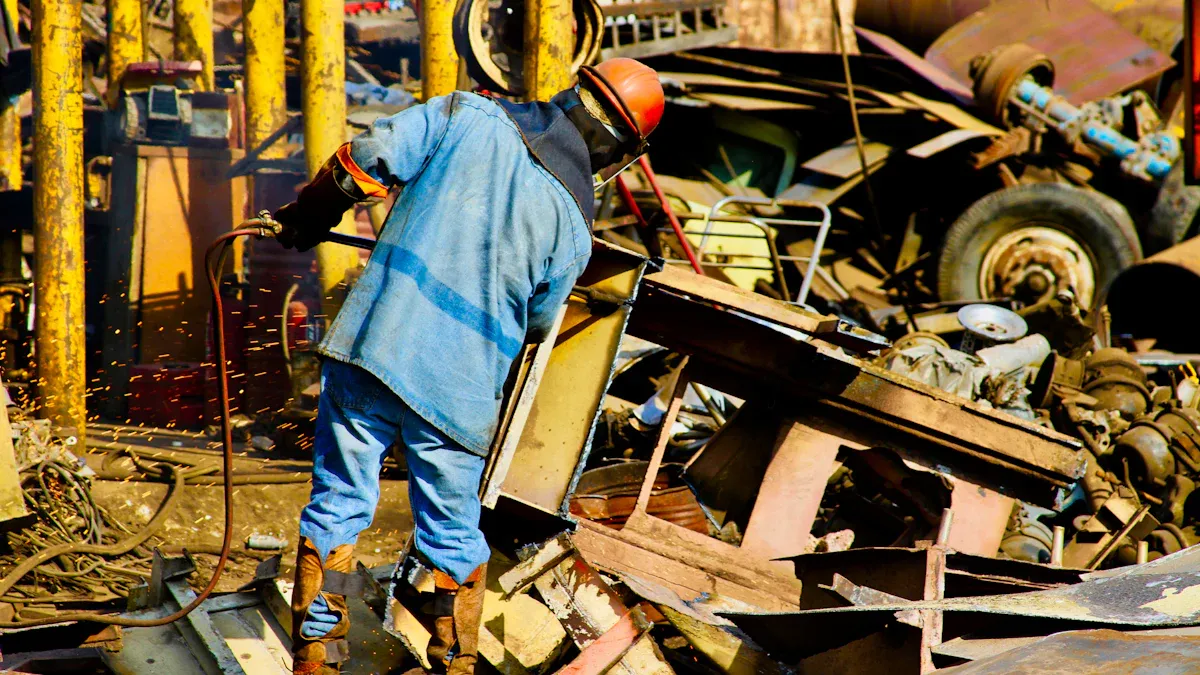What Metals Can an XRF Analyzer Detect?
XRF analyzers can detect a wide range of metals, including gold, silver, platinum, palladium, rhodium, copper, nickel, zinc, iron, tin, lead, chromium, cobalt, and many others. These devices are capable of identifying both pure metals and complex alloys with high precision. Whether in jewelry retail, metal recycling, quality control, or manufacturing, XRF technology provides fast, non-destructive results that are essential for accurate metal identification and value assessment.

Unlike traditional testing methods that may require cutting, melting, or chemical treatment, XRF analyzers work by scanning the metal surface with X-rays, allowing users to determine its elemental composition within seconds.
Which Metals Can Be Detected by an XRF Analyzer?
XRF analyzers are engineered to measure the elemental composition of a wide range of metals, including:
✔ Precious Metals:
- Gold (Au): Including high-purity 999 and 9999 gold, common in jewelry and bullion.
- Silver (Ag): Detected in jewelry, coins, and industrial materials.
- Platinum (Pt), Palladium (Pd), Rhodium (Rh): Critical PMG metals, especially in catalytic converters and high-end jewelry.
✔ Base Metals:
- Copper (Cu): Common in alloys, electronics, and coins.
- Nickel (Ni): Often found in stainless steel and rechargeable batteries.
- Zinc (Zn): Essential in galvanization processes and brass alloys.
- Tin (Sn) and Lead (Pb): Frequently checked for RoHS compliance.
✔ Steel and Alloying Elements:
- Iron (Fe), Chromium (Cr), Manganese (Mn), Molybdenum (Mo): Commonly found in steel and superalloys used in tools, aerospace, and construction.
- Titanium (Ti), Cobalt (Co), Vanadium (V): Important for medical devices, jet engines, and specialty steels.
✔ Rare and Specialty Metals:
- Tantalum (Ta), Niobium (Nb): Found in electronics and high-performance alloys.
- Uranium (U) and Thorium (Th): Relevant in geological and nuclear industries.
- Cadmium (Cd) and Antimony (Sb): Often present in industrial applications or restricted substances monitoring.
With the right configuration, a modern XRF analyzer can detect elements ranging from potassium (K, atomic number 19) up to uranium (U, atomic number 92).
Why Real Users Choose XRF Analyzers for Metal Detection

From gold buyers to recycling plants, users prefer XRF analyzers because they are:
- Non-destructive: Test without damaging the sample.
- Fast: Results appear in seconds, not minutes or hours.
- Portable: Models like VRAY’s VR-H5 and VR-M5 are handheld and ideal for on-site operations.
- Accurate: Capable of distinguishing minute differences in purity and composition.
- User-friendly: Intuitive touchscreens and automated software reduce training time and human error.
These features are critical in industries where time, accuracy, and material integrity directly impact profitability and trust.
Recommended VRAY XRF Analyzers for Metal Detection
At VRAY Instruments, we design XRF analyzers that serve real business needs — whether you’re managing a retail jewelry store, operating a recycling line, or running a precious metal lab. Here are some of our most trusted devices for detecting a wide range of metals:
🔹 VR-H5 Handheld XRF Analyzer
Designed for mobility and speed, this compact device delivers lab-quality results on the go. Ideal for:
- On-site gold and silver testing
- Mobile recycling operations
- Pawn shop evaluations
Key Features:
- Lightweight, portable design
- Dual-beam detection
- Smart battery system and drop protection
- Optimized for low detection limits
🔹 VR-M5 Portable XRF Gold Tester
For professionals who need high precision with minimal setup, the VR-M5 is your best bet. Recommended for:
- Jewelry testing in stores or exhibitions
- Field inspections
- Precious metal authentication
Key Features:
- Si-PIN detector for high accuracy
- Built-in HD camera and touchscreen
- User-defined test duration
- All-day battery support
🔹 VR-X5 Benchtop XRF Analyzer
Tailored for labs and retail environments, the VR-X5 combines advanced performance with ease of use.
Key Features:
- Detects over 20 metal elements
- Fully integrated PC and display
- Customizable reporting and analysis
- Highly sensitive to trace elements
🔹 VR‑T9 High-Purity Gold Analyzer
For clients who demand the highest precision, including 99999 gold analysis, the VR-T9 is the ultimate solution.
Key Features:
- Precision up to ±0.001%
- Spectrum comparison mode
- Fully customizable test reports
- Large test chamber for various sample shapes
How to Choose the Right XRF Analyzer for Your Needs
When selecting an XRF analyzer, consider:
| Factor | Consideration Example |
| Portability | Choose handheld (e.g., VR-H5) for field or mobile use |
| Precision | For 9999 or 99999 gold, opt for VR‑T9 |
| Element Range | Most VRAY analyzers cover K to U (No. 19 to 92) |
| Material Type | Jewelry, alloys, electronics, coatings, etc. |
| Testing Environment | Storefront, lab, factory floor, or off-site |
If you’re unsure, our expert team is ready to recommend the ideal model based on your business type, sample material, and precision requirements.
Final Thoughts
XRF analyzers are versatile tools that can detect a broad spectrum of metals with remarkable precision. Whether you’re analyzing pure gold, verifying jewelry content, recycling scrap, or ensuring compliance, VRAY Instruments offers industry-leading solutions designed to simplify your workflow and increase your confidence in every test.
We’re here to support your precious metal testing needs — with the right equipment, the right technology, and the right service.
Frequently Asked Questions
Q1:Can XRF analyzers detect gold-plated items?
A1:Yes. VRAY analyzers can detect both surface plating and base material, especially when using models designed for coating analysis like the VR-T5 or VR-T6.
Q2:Is it possible to test non-metallic materials with an XRF analyzer?
A2:Primarily, XRF is optimized for metals and alloys, but certain models can analyze plastics or ceramics for heavy metals like lead or cadmium, especially in RoHS compliance scenarios.
Q3:How accurate are VRAY’s XRF devices compared to fire assay?
A3:While fire assay is the traditional benchmark for gold purity, VRAY’s high-end models such as VR-T9 achieve ±0.001% accuracy, making them highly reliable for both field and lab use.
Q4:Do I need to prepare the sample before testing?
A4:Usually not. XRF is a non-destructive method that doesn’t require cutting or polishing. However, cleaning surface contaminants (like dirt or oil) may help improve accuracy.
Q5:What’s the difference between a handheld and benchtop analyzer?
A5:Handheld analyzers like VR-H5 are portable and suited for field work. Benchtop models like VR-X5 or VR‑S6 offer more stability and are preferred for fixed-location labs or high-traffic retail settings.

WhatsApp
Scan the QR Code to start a WhatsApp chat with us.